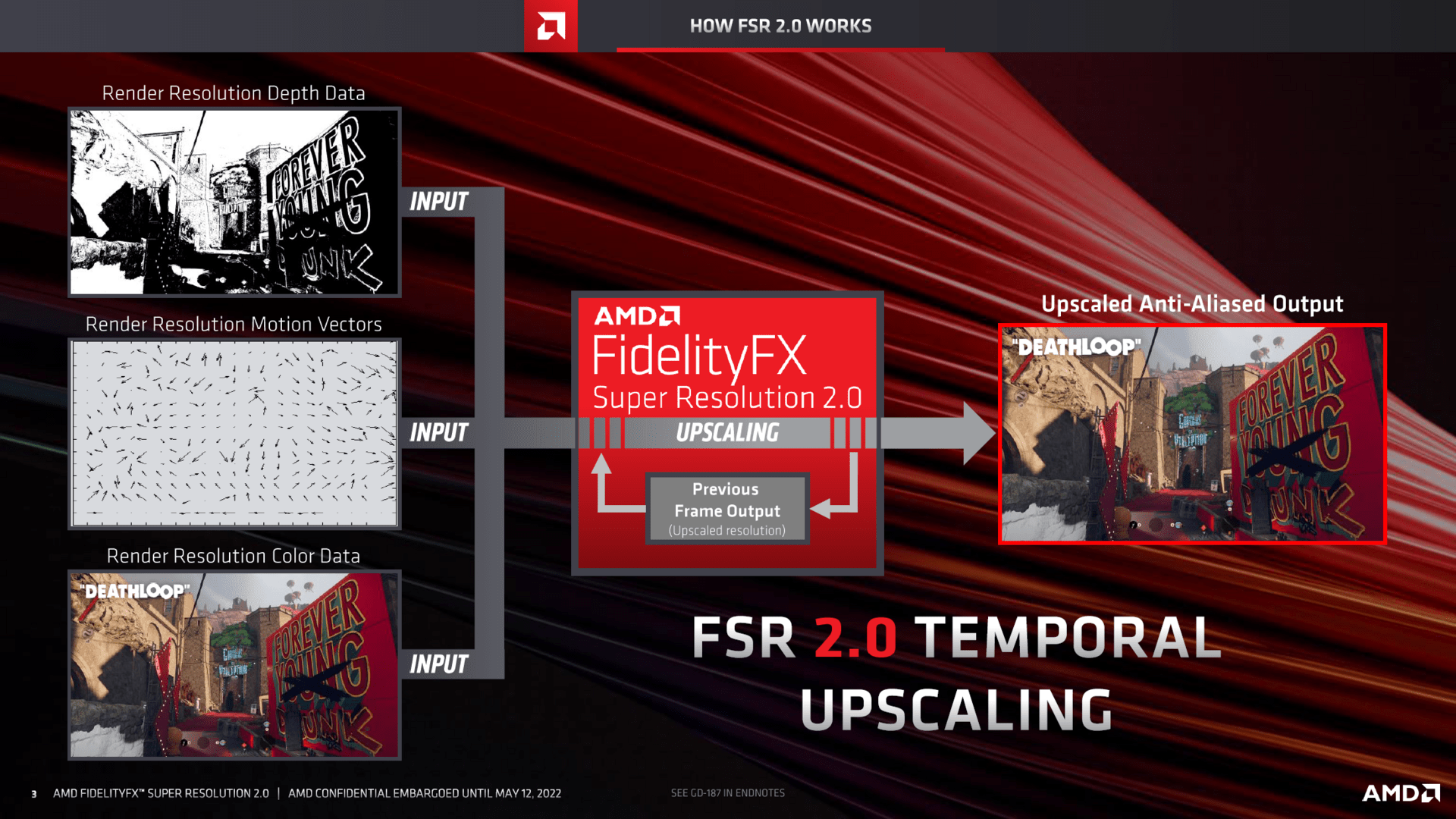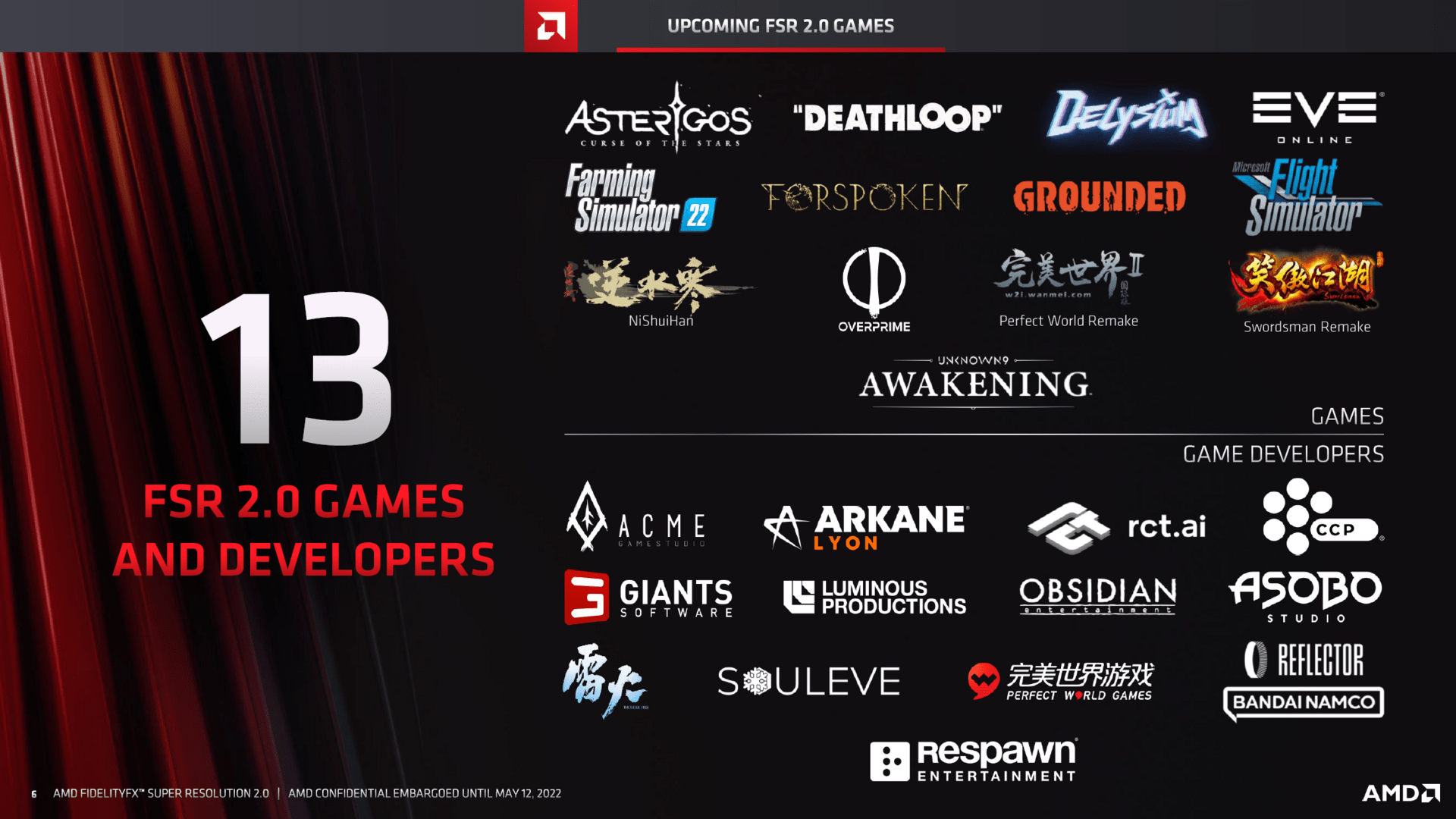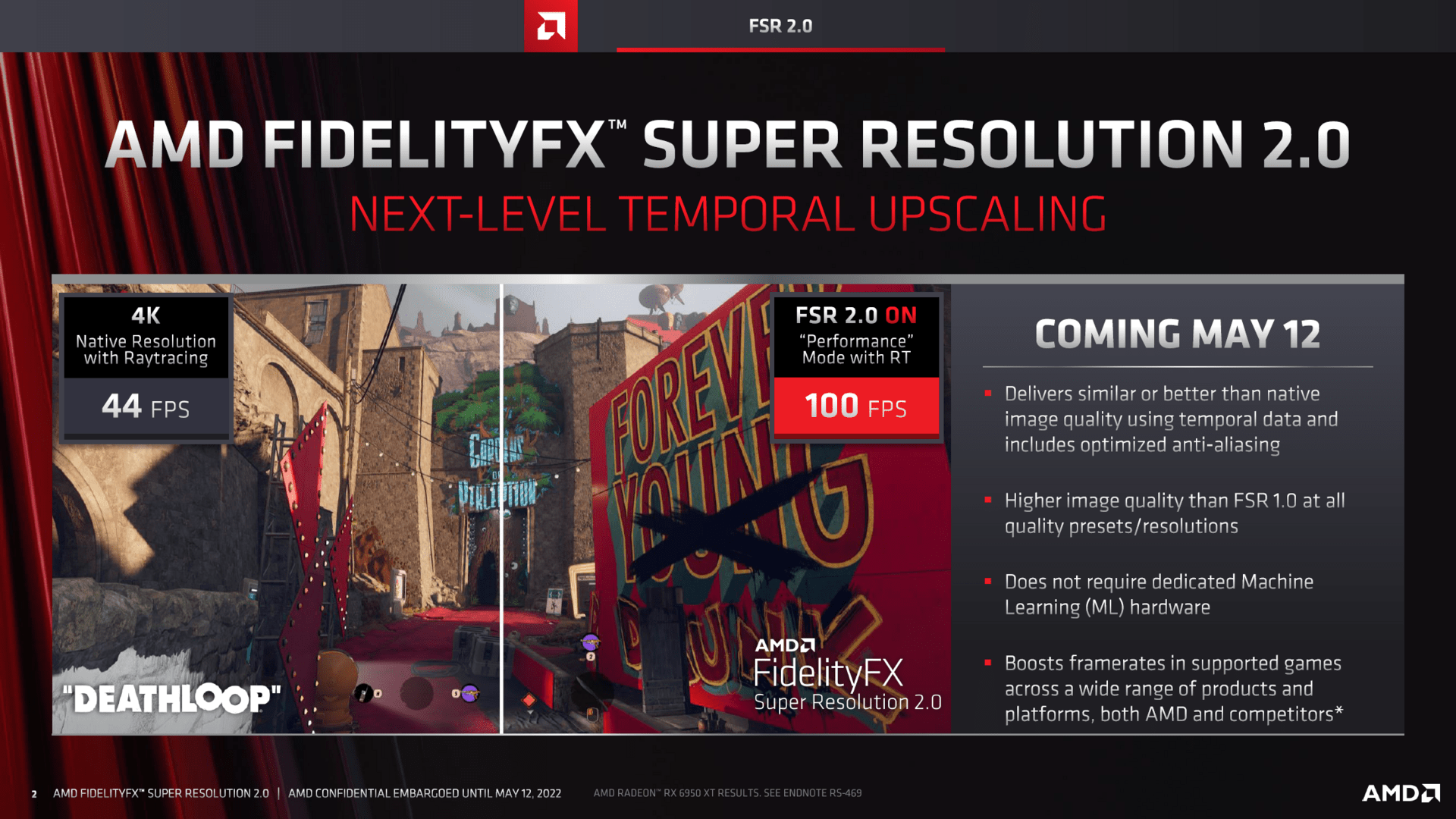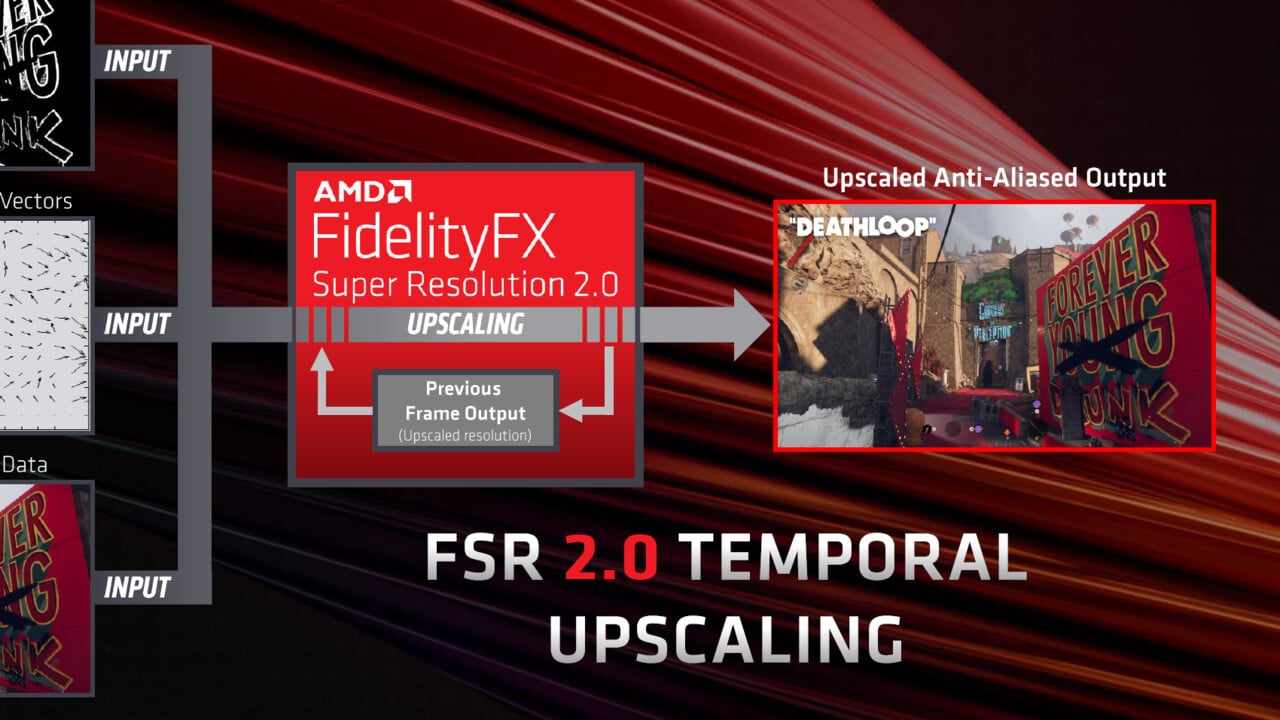AMD FSR 2.0, FSR 1.0 and Nvidia DLSS in comparison
: Test |CUP | Specs |Config
Deathloop is the first game to support AMD FSR 2.0. The comparison of AMD’s temporal upsampling with the predecessor FSR 1.0 and Nvidia DLSS shows: FidelityFX Super Resolution 2.0 is much better, FSR 1.0 doesn’t stand a chance. The test clarifies in detail how big the differences are and whether it is also sufficient for Nvidia’s DLSS 2.0.
Updated 05/17/2022 11:02 am
Updated 05/13/2022 11:03 am
FSR 1.0 vs. FSR 2.0 vs. DLSS 2.0
A year ago, AMD presented FSR 1.0 (test), a first competitor to Nvidia’s DLSS, whose approach without so-called temporary components also had its advantages. But overall, FSR 1.0 did not come close to DLSS. AMD was also aware of this from the start, and it was not without reason that the new technology was born under the name “FidelityFX Super Resolution 1.0”. From the beginning it was clear: A second version will follow.
With the announcement of FSR 2.0 in March 2022, after countless rumors, it was official that the second iteration would face DLSS 2.0 directly. Although still without machine learning in the background, but with a temporal solution that includes information from past frames in the upsampling, FSR 2.0 follows in the footsteps of DLSS 2.0. Whether the results can also be linked to DLSS can now be seen in Deathloop.
Premiere for FSR 2.0 via patch in Deathloop
Because it is a little bit surprising that a patch for the Arkane game Deathloop (test) appears today and adds FSR 2.0 to the already supported technologies FSR 1.0 and DLSS. ComputerBase had the opportunity to take a first look at it two days in advance and will clarify in the following sections whether the qualitative leap is as large as hoped.
After the latest update in the graphics menu, Deathloop offers FSR 2.0 in the levels “Quality”, “Balanced” and “Performance” as an upscaling method in addition to FSR 1.0 and DLSS 2.0 – the developer Arkane does without the optional “Ultra Performance”.
Enable AMD FSR 2.0 in Deathloop
Bild 1 von 5
For the time being, the editors only used the quality levels “Quality” and “Performance” on all three techniques. In FSR 1.0, on the other hand, “Balanced” and “Ultra Quality” were omitted due to time constraints. The target resolution of 3,840 × 2,160 will primarily play a role in the test, since that is where the additional performance is needed the most. But 1,920 × 1,080 and 2,560 × 1,440 are also taken into account.
This is AMD FSR 2.0: The technology in detail
FidelityFX Super Resolution in the original version 1.0 is a classic “spatial upscaler”. A spatial upscaler analyzes each frame/rendered image and tries to improve its image quality based on this information. In contrast to pure scaling, an attempt is made to recognize motifs and objects in the image and then to optimize them in a targeted manner. The image is then optionally sharpened with FidelityFX CAS if the developer wants it.
FSR 2.0 uses a temporal component
FSR 2.0, on the other hand, is temporal upsampling, like Nvidia’s DLSS 2.0. This means that the database is not only based on the current frame, but also on additional data from previous frames to improve the image quality. And with the additional information, the image quality can also be improved in terms of image reconstruction and image stability, which is not possible with a spatial upscaler.
The lower the render resolution, the more advantages temporal upsampling can gain over the spatial variant from the additional data from previous frames. But even with a high resolution, the advantages are clear. And that’s why a temporal method can produce even better graphics than a higher native resolution, simply because there is more information available.
In addition, like DLSS 2.0, FSR 2.0 replaces the game’s own anti-aliasing and uses its own method to reduce the annoying steps. FidelityFX CAS for sharpening is still on board, here the developer can also optionally install a sharpness controller.
FSR 2.0 and DLSS 2.0 are similar in many ways
AMD’s wording when describing FSR 2.0 is very similar to Nvidia’s when describing DLSS 2.0. Accordingly, FSR 2.0 shouldsimilar or better image quality than the native resolution” reachable. But it is not only in this point that the two technologies are very similar in their presentation to the player, the available modes are also virtually identical with “Quality”, “Balanced”, “Performance” and “Ultra Performance” including their internal render resolutions. “Ultra Performance” is only one option, the other three modes will always be available.
FSR 2.0 does without a neural network
That Nvidia uses a machine process in DLSS 2.0 to combine the information from the previous frames, while AMD “uses advanced algorithms that can detect relationships between different frames and resolutions‘, however, there remains a difference. With AMD, it should be up to the GPU alone to “understand” the image before upscaling, while with Nvidia, every supported game is first analyzed in a neural network. The “trained” knowledge should further improve the result. Whether AMD’s purely local approach works just as well as with a neural network in the background remains to be seen.
No neural network has the advantage that FSR 2.0, unlike DLSS, does not require matrix units (tensor cores) for (optional) acceleration, the calculations for FSR 2.0 are carried out on the normal shader units. In addition, AMD does not bind the technology to its own Radeon graphics cards, so that FSR 2.0, like FSR 1.0, will work on any current GPU – regardless of whether it is from AMD, Nvidia or Intel.
In addition, at least theoretically, there is the advantage that FSR 2.0 potentially has fewer problems with classic DLSS problems such as ghosting or smearing. In a first example, the test clarifies whether this will actually be the case – after all, errors can occur when the data is added up, even without AI. In addition, FSR 2.0 will be open source, although the source code is not yet available.
Lots of pros and cons vs. FSR 1.0
In terms of quality, FSR 2.0 should be clearly superior to FSR 1.0, at least in theory, but there will also be disadvantages. FSR 2.0 should initially only work in conjunction with DirectX 12, Vulkan support is expected to follow shortly. However, there is currently no talk of further APIs. Additionally, FSR 2.0 will not be enforceable like FSR 1.0 in the form of Radeon Super Resolution (RSR) in a game that doesn’t actually support FSR 2.0.
Because so that the information from the various old frames can be correctly taken into account, FSR 2.0 must be able to access so-called motion vectors, which show the algorithm where which pixel has “migrated” to. Without this information, temporal upsampling cannot work. Aside from the vectors, FSR 2.0 must also have access to the depth buffer and the color buffer – as a result, upsampling is integrated into the game’s render pipeline much earlier than FSR 1.0.

AMD FidelityFX Super Resolution 2.0 (Bild: AMD)
Bild 1 von 3


The effort for the developer is higher
Not for the player, but important for the developer is the aspect that the implementation of the second version like that of DLSS 2.0 takes more time than for the first iteration. FSR 2.0 should be the easiest to integrate if a game already supports DLSS 2.0, since both technologies have almost identical requirements. According to AMD, the implementation should then take three days, even if it is unclear how many employees were estimated for this. In addition, there will be a FSR 2.0 plug-in for Unreal Engine 4 and Unreal Engine 5, which will significantly reduce integration times even without prior DLSS integration.
It should take less than two weeks if the game at least supports render resolutions and TAA that are independent of the display resolution – because then there are already the motion vectors that are important for FSR 2.0. According to AMD, if TAA is not supported, around three weeks are planned. And if the game doesn’t support TAA and independent render and display resolutions, the integration should take four weeks or more.















